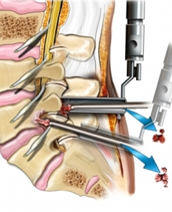
Percutaneous Discectomy
Percutaneous means “through the skin” or using a very small cut. Discectomy is surgery to remove herniated disc material that is pressing on a nerve root or on the spinal cord.
There are many different kinds of percutaneous discectomy procedures. All of them use small instruments that are inserted between the vertebrae and into the middle of the disc. Most of the time they are done in a surgery center using local or general anesthesia.
X-rays help guide the movement of the instruments during surgery. The surgeon can remove disc tissue by either:
- Cutting it out.
- Sucking out the center of the disc.
- Using lasers to burn or destroy the disc.
What To Expect After Surgery
You can expect to go home on the same day you have the procedure.
You can use prescription medicine to control pain while you recover.
For several weeks after surgery, you’ll need to avoid long periods of sitting and avoid bending, twisting, and lifting.
Why It Is Done
Lumbar (low back) percutaneous discectomy may be done if:
- Your medical history, physical exam, and diagnostic tests (such as MRI, CT scan, or myelogram) show that the disc is bulging, and the material inside the disc hasn’t ruptured into the spinal canal.
- Pain and nerve damage have not improved after 4 or more weeks of nonsurgical treatment.
- Your symptoms are very bad and get in the way of doing normal activities.
- There are signs of serious nerve damage in your leg that may be getting worse. These signs include severe weakness, loss of coordination, or loss of feeling.
How Well It Works
Although surgery for a lumbar herniated disc doesn’t work for everyone, it works well for many people. Regular discectomy works a little better than percutaneous discectomy. 1 Risks
During a percutaneous discectomy, the surgeon has no way of seeing the herniated disc or the pinched nerve camera.gif.
